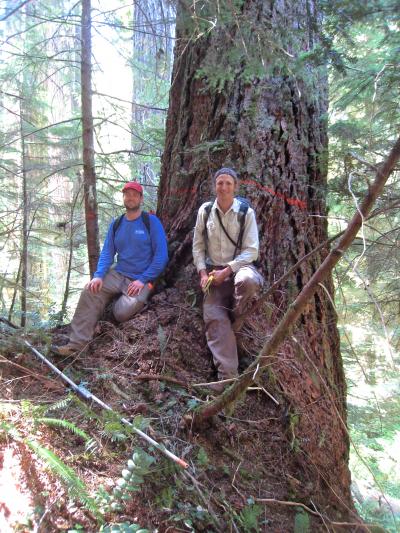Size and age of plants impact their productivity more than climate, study shows

Sean Michaletz (left) and Brian Enquist take a break from measuring trees in an old-growth forest in Oregon. The large tree behind them is an example of an old, large tree with a low growth rate, absorbing carbon from the atmosphere and making food for animals like squirrels and birds. Credit: Irena Simova
The size and age of plants has more of an impact on their productivity than temperature and precipitation, according to a landmark study by University of Arizona researchers.
UA professor Brian Enquist and postdoctoral researcher Sean Michaletz, along with collaborators Dongliang Cheng from Fujian Normal University in China and Drew Kerkhoff from Kenyon College in Gambier, Ohio, have combined a new mathematical theory with data from more than 1,000 forests across the world to show that climate has a relatively minor direct effect on net primary productivity, or the amount of biomass that plants produce by harvesting sunlight, water and carbon dioxide.
The findings will be available as an advance online publication by the journal Nature on July 20.
“A fundamental assumption of our models for understanding how climate influences the functioning of ecosystems is that temperature and precipitation directly influence how fast plants can take up and use carbon dioxide,” said Enquist, a professor in the UA's Department of Ecology and Evolutionary Biology whose research lab led the study.
“Essentially, warm and wet environments are thought to allow plant metabolism to run fast, while cold and drier environments slow down metabolism and hence lower biomass production in ecosystems,” he said. “This assumption makes sense, as we know from countless experiments that temperature and water control how fast plants can grow. However, when applied to a the scale of entire ecosystems, this assumption appears to not be correct.”
To test the assumption on the scale of ecosystems, the team developed a new mathematical theory that assesses the relative importance of several hypothesized drivers of net primary productivity. That theory was then evaluated using a massive new dataset assembled from more than 1,000 different forest locations across the world.
The analysis revealed a new and general mathematical relationship that governs worldwide variation in terrestrial ecosystem net primary productivity. The team found that plant size and plant age control most of the variation in plant productivity, not temperature and precipitation as traditionally thought.
“This general relationship shows that climate doesn't influence productivity by changing the metabolic reaction rates underlying plant growth, but instead by determining how large plants can get and how long they can live for,” said Sean Michaletz, lead author of the study and a postdoctoral researcher at the UA Department of Ecology and Evolutionary Biology. “This means that plants in warm, wet environments can grow more because their larger size and longer growing season enable them to capture more resources, not because climate increases the speed of their metabolism.”
The finding does not, however, mean that climate is unimportant for plant productivity, the researchers said.
“Climate is still an important factor,” said Michaletz, “but our understanding of how it influences ecosystem functioning has now changed.”
The team's new findings suggest that mathematical models used for predicting the effects of global climate change can be improved by accounting for the effects of plant size and plant age on net primary productivity.
“Understanding exactly how climate controls net primary production is important for understanding the plant-atmosphere feedbacks that control climate change,” said Michaletz.
Enquist said: “In other words, to better predict how ecosystems will change with climate, we need to understand what influences the amount of plant biomass in a given area as well as its age.”
The study was funded through an NSF MacroSystems award (1065861), a fellowship from the Aspen Center for Environmental Studies, and through support by the National Natural Science Foundation of China (31170374 and 31370589) and the Fujian Natural Science Fund for Distinguished Young Scholars (2013J06009).
The DOI for the above paper will be10.1038/nature13470. Once the paper is published electronically, the DOI can be used to retrieve the abstract and full text from the Nature website by adding it to the following url: http://dx.doi.org/.
An animated visualization of net primary productivity across the globe is available on NASA's Earth Observatory website: http://eoimages.gsfc.nasa.gov/images/globalmaps/data/mov/MOD17A2_M_PSN.mov
Media Contact
All latest news from the category: Ecology, The Environment and Conservation
This complex theme deals primarily with interactions between organisms and the environmental factors that impact them, but to a greater extent between individual inanimate environmental factors.
innovations-report offers informative reports and articles on topics such as climate protection, landscape conservation, ecological systems, wildlife and nature parks and ecosystem efficiency and balance.
Newest articles

Properties of new materials for microchips
… can now be measured well. Reseachers of Delft University of Technology demonstrated measuring performance properties of ultrathin silicon membranes. Making ever smaller and more powerful chips requires new ultrathin…

Floating solar’s potential
… to support sustainable development by addressing climate, water, and energy goals holistically. A new study published this week in Nature Energy raises the potential for floating solar photovoltaics (FPV)…

Skyrmions move at record speeds
… a step towards the computing of the future. An international research team led by scientists from the CNRS1 has discovered that the magnetic nanobubbles2 known as skyrmions can be…





















